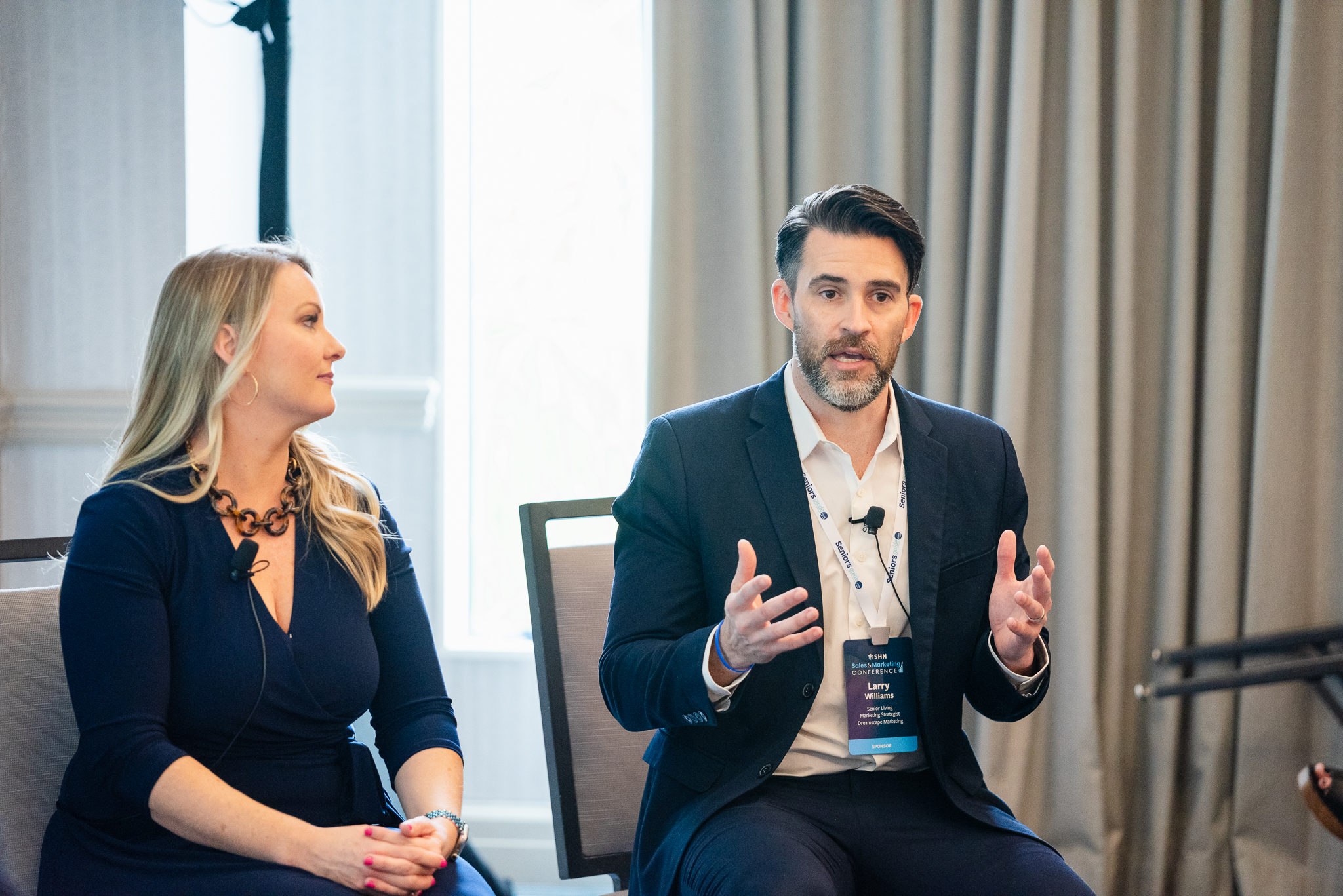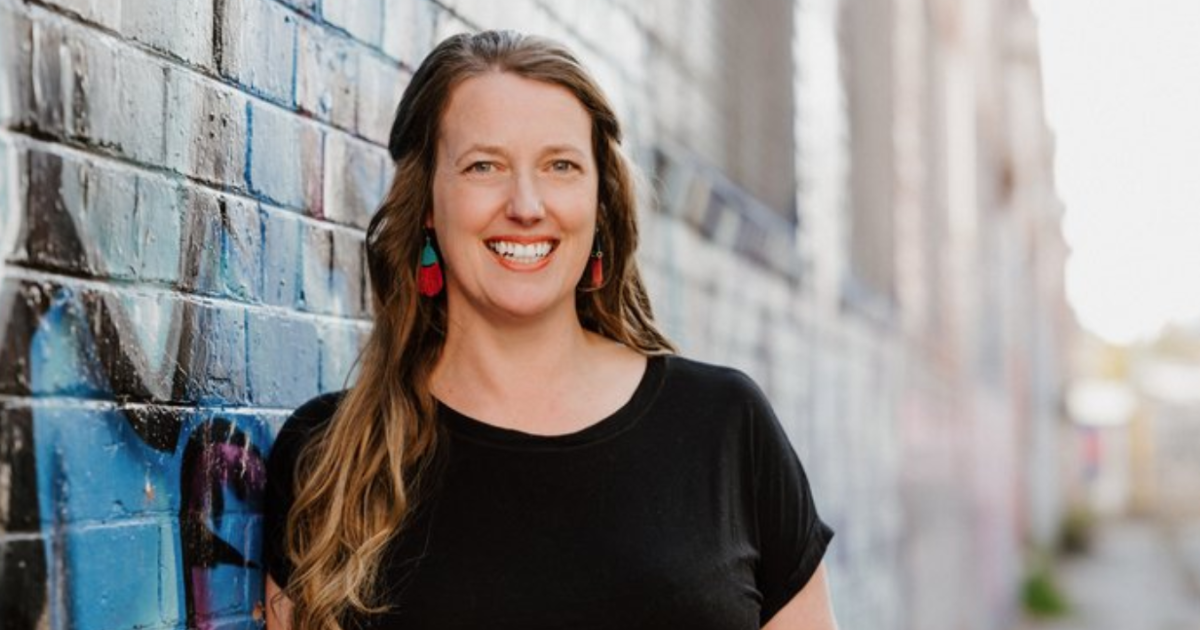This article is sponsored by Dreamscape Marketing, now a part of Unlock Health. This article is based on a Senior Housing News discussion with Larry Williams, Marketing Strategist for Dreamscape, and Christy Van Der Westhuizen, SVP of Sales and Marketing for Legend Senior Living. The discussion took place during the recent Senior Housing News Sales & Marketing Conference in Tampa, Florida. The article below has been edited for length and clarity.
Dreamscape, which recently joined forces with Unlock Health, has conducted senior housing industry research in partnership with Senior Housing News to gauge the industry’s sentiment on marketing — successes, shortcomings and the new challenges that lie ahead.
Senior Housing News: One question in your recent survey was “What will be the greatest driver of census growth in 2024?” I don’t think it’s a big surprise that a majority of respondents [in your research] said digital marketing. What are the takeaways?
Larry Williams: There’s no surprise here: 57% [said digital marketing] and I expect it to continue to move upwards. Digital marketing provides timely metrics, and you can adjust on the fly. Metrics will help guide future positioning and future strategy. We also want to always have that conversation of how you’re integrating this information and these data points. For that reason, digital marketing will be at the top and will continue to rise up. One thing I always like to try to keep in mind is what’s that brand strategy before that event that makes people think, “Okay, I need to look at senior living?”
What’s that triggering event, and how do you build a brand platform? That being said, I think people continue to need to think about traditional marketing and social media, to lay the groundwork for what that brand looks like, and so when that triggering event does happen, you are top of mind. I wouldn’t overlook some of the other metrics just because it’s an evolving, and all-encompassing strategy.
SHN: Can you talk about what you’re seeing regarding census growth and within that digital perspective, what you are looking at?
Christy Van Der Westhuizen: Digital marketing absolutely is going to be the number one driver of census growth, but I think the thing that really stands out to me is personal referrals.
Man, oh, man, if that’s not like a daily topic that we have at Legend is how can we get more personal referrals? I’m talking about resident referrals, family referrals, and people who think of us very fondly. Are they referring to us? Do we have a referral program that keeps us top of mind for those personal referrals? We need to ask for those referrals, not just assume that people are going to be referring to us.
SHN: Under the question, “What is the primary business objective marketing aims to achieve?” we saw 80% responding “New resident acquisition.” We have operators telling us all the time about the different strategies they’re taking. Christy, what are you doing at Legend [to drive that]?
Van Der Westhuizen: New resident acquisition is certainly a big piece of our 2024 puzzle. I will say, with a tiny caveat, it’s not just new resident acquisition, it’s [also] current resident retention. We speak so much about, “Hey, let’s get new residents, let’s get new move-ins, let’s build occupancy,” but I think of occupancy as a very large puzzle.
Part of the puzzle pieces are those new residents coming in and helping you fill your building. One way to keep your building full is having wonderful resident retention and satisfaction. That’s something that we are looking at very critically — keeping current residents happy, healthy, and referring people to our communities. That’s really important.
Williams: Of course, that’s why we’re all here, is new resident acquisition, but what stood out to me is that brand awareness [as a goal] went up by 5% compared to last year. I think that’s going to be key in 2024.
Your brand is your culture, your location, your staff. What’s that story you’re telling? Far too often we think: What’s our brand? It’s the dining room, the swimming pool. It’s really: what is that story you’re trying to tell? What separates us from everybody else? It’s the stories we tell.
SHN: Christy, what does brand awareness mean to you?
Van Der Westhuizen: I think it really means what is the sentiment that someone has when thinking about your brand? Last year, we talked a lot about video content and driving stories through video. Text is great, but pictures are better. Are we showcasing the lifestyle and bettering lives through video? I think that that’s really important for brand strategy — to tell our story in lots of different ways and not just writing it down.
Williams: It’s such an integrated process. You want each piece to connect to the next piece. It’s a funnel that keeps moving around.
SHN: We’ve heard from so many operators about how they’ve evolved their strategy, even in the last four years, to really be more digital-focused, but also to really how to capture those relationships and to be able to raise their brand awareness through that relationship building. Fifty percent of respondents said that they were going to really focus on pay-per-click advertising, and then 49% also on content, followed by 46% with social media. Larry, what do these top three really say to you?
Williams: What’s funny about this is that [Dreamscape] specializes in those services, but what stood out to me was actually the marketing automation, which is at 28%. The reason that stood out to me is because compared to last year, it went up by 9%.
The other thing that stood out to me is AI, at 5%.
I think there’s some FOMO right now with AI. As we go through the year, it’s going to continue to creep up, as we’re going to find a lot more efficiencies. Mobile is at 3%, but mobile affects that first half. When I think about mobile, I think about how retail establishments are interacting with us currently. Whether it’s restaurants, health care providers, heck, my mechanic reached out to me through text messages and provided links of updates with [my] car and everything like that. That’s where it’s all going, is with our phones. Even Google, they rank on mobile speed, not desktop speed. The mobile side of this affects everything else.
Van Der Westhuizen: Web design is where we are going to spend a lot of our efforts. Prospects and their families really want to be in control of their own journey. They want the information they want, when they want it, how they want it, and so we need to be adaptable and flexible to give them exactly what they want when they want it.
In 2024, Legend is undergoing a complete web redesign, and thankfully with the help of Dreamscape, we’re going to be spending a lot of time and effort to really simplify our message, make sure it resonates really well with the imagery and the content, and make sure it’s easy to use and easy to navigate so people can get the information how they want it, when they want it. They’re in control of their own journey.
Williams: A lot of that has to do with the content and the usability. You have to make it really easy to navigate, but you want to attract them to the site. The right SEO practices are really important. I think some of the best advice I’ve ever received as a parent, especially as my daughters are 10 and 13, is to be where they are. Not physically, but emotionally.
I know it sounds over the top, but when it comes to our digital presence, we want to be where our clients are searching, or be where they are in this emotional state, whether it’s the adult child decision maker or the senior living seeker. I think it’s really providing that content, answering questions, and being really proactive on that brand strategy, and making the process as easy as possible for them.
SHN: With the redesign that Legend is undergoing right now, how do you promote buy-in? How do you bring the whole team on board to show them all these new aspects so they can communicate what they’re being able to stand behind to new residents?
Van Der Westhuizen: We’re figuring it out as we go along, but again, just the simplicity and the clarity of the message, I think, is going to be important. I think that our sales team also needs to have a piece of the puzzle in creating the website as well. It’s a giant group effort, and we’re looking forward to seeing it unveiled later this year.
SHN: What is the journey AI might take in 2024? Is it people just buying in because they don’t want to get left behind?
Williams: I think there are different buckets. On the marketing side, there are a lot of efficiencies, whether it’s video or image creation. Then I think it’s going to continue to change how we approach customer service. I encourage everyone to YouTube the video showing Tesla’s customer service — it’s all through AI. You have to listen closely to know it’s not a real human being who’s being responsive.
I’m not saying we need to go down that path, but you can see where that’s going. Whether it’s the content side with marketing, or the customer service, or just integrating some of these data points, I think AI is going to make a lot of processes a lot more efficient.
On that topic, it’s really important to continue to be human with the residents and their families. If you can provide that human element, it will make you stand out.
SHN: In the survey, when it came to rating the challenges of messaging to different audiences, we saw that 63% said there would be somewhat of a challenge of making that message be cohesive across their different platforms, and then 19% said it would be very challenging. When you look at this and you’re just thinking about just that messaging and that challenge of having different platforms, what are you really thinking about?
Williams: I think about the messaging to the adult child decision maker and the senior living seeker as two different messages. You’ve got one group who’s looking for a continuation of lifestyle, freedom, and a community. The other wants peace of mind and assurance that their parents are being taken care of and a relief of that burden of care.
How do you connect both groups in their own vehicles, but then guide that conversation so they can have that conversation together? I think the right digital strategies can help set those conversations up so they can connect and have good dialogue. I think that’s where we need to be — continue to watch where those metrics are taking us, and so we can better identify how to improve those processes.
SHN: Are there any strategies that have stood out to you recently?
Williams: We get all of our answers from Google. I think 80% of healthcare journeys start with Google. That being said, a lot of times, going back to that triggering event, what people are searching for. Focus that content and that SEO to answer those questions, and then that’s going to help drive those responses. You want to really focus that on that local level.
Van Der Westhuizen: I fall into a “somewhat challenging” group. I think it’s somewhat challenging to have different messages, but I think technology can help us with that, especially as we move forward with, again, new website, new messaging is going to be how can we tailor and personalize the experience for that specific person, and then another person either goes on the website and their messaging might be a little bit different. Again, I haven’t figured it out yet, but I know there are much more tech-savvy people than me who can help with personalizing every digital experience, and so that way, you can have two different messages running at the same time for different audiences.
SHN: We’ve all talked about Google reviews as being key to representing your brand when teams maybe aren’t as active. How do you integrate or think about your public-facing component that may not be part of a team member’s day-to-day?
Williams: When I think about that public-facing image and also integrating that with those Google business reviews, you’re really trying to get people to help tell that story. If you can help guide them on how to do that, it’s going to help a lot. That’s one thing I’d always recommend is not only providing a great service because that’s who you are as a community, but also help them share that experience and with the knowledge of you’re not just doing this for us, but you’re doing this for others who need to hear your story. I would frame that as, it’s the why, and then the what, and then the how.
Van Der Westhuizen: We ask for feedback and equip our teams on how to ask for that feedback personally. When an adult daughter comes to the nurse and says, “Hey, mom’s doing great. Thank you so much,” it’s being able to say, “Hey, would you mind giving us that feedback in a review? That would mean the world to us.” Just having that conversation and that personal ask. Then also I think that the easiest thing to do is have them do that as soon as humanly possible.
Because sometimes when I have a really great experience as a consumer, I think, “Oh, I’ll leave them an amazing review,” and then I never do. Asking them for that and say, “Hey, would you mind doing that today? That would be so great. Then I can share it at standup tomorrow.” With that expectation of, “Hey, we’re actually counting on this.” I think, again, it’s the human element that will never, ever leave our industry.
SHN: In the survey, almost three-fourths of your respondents had said that they were going to increase their social media presence. I don’t think that’s a surprise, but Larry, for you, what’s that takeaway?
Williams: Everyone has stories. The staff, the residents, the community, and the location, there are so many great stories. I think social media can provide these stories in a very authentic style if done correctly. Include video, and I think that really can bring a different level of traction that can build that brand awareness and really get in front of people.
More people are searching through TikTok, and that number keeps increasing. Everybody’s getting comfortable with Facebook, but let’s go ahead and move towards Instagram and TikTok and start adopting those platforms as well.
SHN: At Legend, when you’re thinking about social media marketing from your perspective, what are you really telling your teams and how do you want them to interact with the social side?
Van Der Westhuizen: Part of our strategy is we want to provide social proof for what we are doing matters and what we do every day, there is an element of fun, and there’s an element of learning. That’s what we are telling our teams and asking for them to submit content that helps us tell the story better. It’s a constant conversation that we have
Williams: I know that managing this on the local level is very challenging. What we always recommend is utilizing templates and a strategy based in quarters. It’s easy for people to adopt and run. You don’t want these random acts of social media postings. You want there to be a strategy behind it. That’s something else I’d recommend as well is manage it at the corporate level, but be able to guide it and process it at the community level.
Van Der Westhuizen: It’s consistency too. We have a minimum expectation of three times a week of community-based content. Now, we do some corporate messaging, National Watermelon Day, whatever, but our minimum standard is three times a week.
Williams: It helps with residents, future residents, staff, and the recruiting as well. It touches so many different aspects of that journey.
SHN: Finally, we asked about the change of the marketing spend over the next 12 months, whether that would increase, stay the same or be reduced.
Williams: I looked at this, the headwinds and tailwinds. The tailwind is that everybody can take a picture and send it to their leadership, and say, “Hey, we need to invest more because everybody else is.” The headwinds is it’s getting more competitive, especially in digital marketing. It’s really competitive. You’re going to have to outperform other groups, especially on the local level.
Van Der Westhuizen: I think it’s up to the organization and what your expectations are and what the understanding of digital marketing spend as well. I think that there are companies out there that are extremely innovative and really want to try different things and look at other industries as a good inspiration. Then there are companies that want an exact return on investment for every dollar that they spend, and so it’s just the comfort level between what you’re wanting to do, and what you’re wanting to invest, and what you’re willing to try from a digital marketing perspective.
When you’re looking at your strategy, we keep talking about the website being your digital front door… make sure that foundation is strong. I think that’s one of the first steps, is just to audit that, make sure that’s a sound structure, and then you can build upon that, because all of these integrated phases will go through the website. I would say that’s something, just a good starting point, is the website, for sure.
To learn more, about navigating senior living marketing and sales in 2024 please reach out to Larry Williams, senior living marketing strategist for Unlock Health or visit https://www.unlockhealthnow.com.



